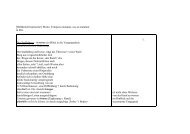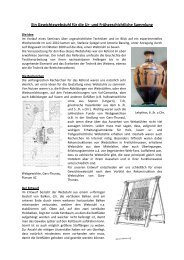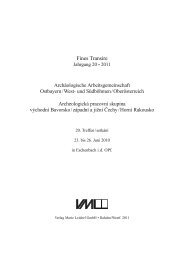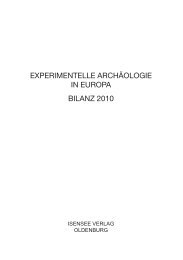Thorsten Uthmeier & Jürgen Richter
Thorsten Uthmeier & Jürgen Richter
Thorsten Uthmeier & Jürgen Richter
Create successful ePaper yourself
Turn your PDF publications into a flip-book with our unique Google optimized e-Paper software.
Chapter 14<br />
flake, but is much smaller (Fig. 14-19, 5). The third<br />
surface shaped tool is a small but thick, plano-convex<br />
bifacial convergent scraper (Fig. 14-16, 8). All<br />
surface shaped tools show signs of reduction and/or<br />
resharpening. In two cases (Fig. 14-19, 1, 5) ventral<br />
thinning, as well as incomplete, large negatives of<br />
older work steps on the dorsal surfaces, speak for<br />
the rejuvenation of parts of the working edges. One<br />
piece, however, underwent a second, more or less<br />
complete facial shaping, and was rejuvenated by a<br />
lateral sharpening flake on its plan (lower) surface<br />
(Fig. 14-16, 8). With the presence of plano-convex<br />
surface shaped bifacial tools, the assemblage belongs<br />
both typologically and technologically to the<br />
Crimean Micoquian (Chabai 2004).<br />
Sortation into raw material units<br />
Among the 51 artefacts larger than 3 cm from level<br />
VI/13, a total of 23 raw material units (RMU) were<br />
recognized (Table 14-1). With the exception of one<br />
unit that consists of five patinated pieces not suitable<br />
for transformation analysis (Table 14-1: RMU<br />
17), all raw material units show a unique combination<br />
of macroscopic a�ributes. In these 22 units, the<br />
number of artefacts ranges from between one (single<br />
pieces) and six pieces (Fig. 14-20). Most of them<br />
consist of single pieces (11 cases) or pairs of artefacts<br />
(6 cases). Only five raw material units reach<br />
numbers of artefacts of between four and six pieces.<br />
According to distinctive a�ributes of raw material,<br />
each of the 22 raw material units mentioned above<br />
represents the result of the flaking of a single nodule<br />
(“workpieces” in the sense of <strong>Uthmeier</strong> 2004a).<br />
Whereas single pieces point to considerable N- and/<br />
or C-transformations, others are more complete.<br />
Even if the total number of artefacts in these raw<br />
material units seems to be (too?) low, they allow a<br />
reconstruction of on-site flaking, blank production<br />
and, in some cases, tool use. In general, it is not so<br />
much the low frequency of artefacts in raw material<br />
units that is problematic: formerly, the same observation<br />
has been taken as a sign for only minor<br />
flaking of a stock of raw material taken from site to<br />
site (<strong>Uthmeier</strong>, Chapter 7, this volume), or as an indication<br />
for the transport of lithics out of the site by<br />
human agents (<strong>Uthmeier</strong>, Chapter 9, this volume).<br />
However, these assemblages were less affected by<br />
post-depositional processes (Kabazi II, level V/1),<br />
or they were found in in-situ (Kabazi II, level V/3).<br />
Level VI/13, on the other hand, is assumed to be in<br />
a secondary position. Although artefacts were not<br />
transported over long distances, the assemblage<br />
might not contain all lithics originally discarded.<br />
Transformation Analysis at Kabazi II, Levels VI/11-14<br />
Fig. 14-14 Kabazi II, Level VI/13: distribution of artefacts<br />
used for raw material sortation and transformation<br />
analysis.<br />
The many single pieces and small raw material<br />
units support this hypothesis. It seems highly likely<br />
that corresponding artefacts of some single pieces<br />
or small raw material units are to be found in levels<br />
VI/11, VI/12 and VI/14, respectively. On the other<br />
hand, the successful sortation of more than one half<br />
of all artefacts (larger than 3 cm) recovered from level<br />
VI/13, and the fact that all other levels bared much<br />
smaller amounts of artefacts, reveals two things:<br />
1. The transportation down the slope did not lead<br />
to a total destruction of the original context.<br />
The existence of workpieces shows that artefacts<br />
were not moved randomly. It has to be<br />
assumed that post depositional processes were<br />
not continuously active over a long period, but<br />
were short, leaving behind at least remnants of<br />
the original context. Archaeological finds were<br />
237







